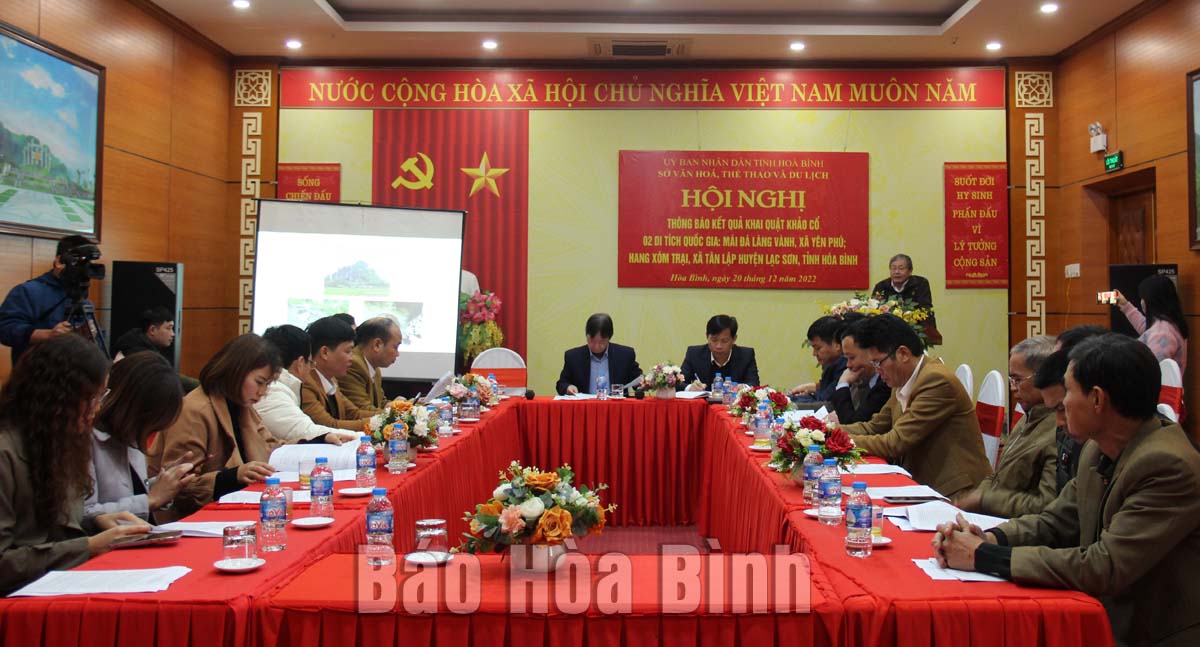
(HBO) - On December 20, the Department of Culture, Sports and Tourism held a conference to announce the preliminary results of archaeological excavations of the two national-level relics, the stone roof of Vanh village in Yen Phu commune and the cave in Trai village in Tan Lap commune (Lac Son). There was attendance of the leaders from the Institute of Archeology, the Center of Prehistory of Southeast Asia, the People's Committee of Lac Son district and the People's Committee of Tan Lap and Yen Phu communes.

Dr. Nguyen Viet, the Director of the Southeast Asian Prehistory Center reported the results of archaeological excavations of the 2 national relics in Trai village and the stone roof of Vanh village (Lac Son).
Implementing Decision No. 1052, dated on May 6, 2022 of the Ministry of Culture, Sports and Tourism on archaeological excavations, the Department of Culture, Sports and Tourism, the Provincial Museum have collaborated with the Institute of Archeology, Vietnam Academy of Social Sciences, the Southeast Asian Prehistory Center to excavate the relics at the national-level relic of the stone roof of Vanh village in Vanh hamlet, Yen Phu commune and the national archaeological site of Trai village in Tan Lap commune (Lac Son). Up to now, the archaeological excavation of the 2 national relics has been completed. The excavation results are a new source of material, contributing to enriching the content of Hoa Binh Culture, making the practical contributions to the work of celebrating the 90th anniversary of its establishment, researching Hoa Binh Culture in Vietnam, honoring the value of cultural heritage, showing gratitude to the French archaeologist, Madeilen Colani, and many generations of the prehistoric researchers, the cultural managers at home and abroad.
The national archaeological relic, the stone roof of Vanh village, the excavation period is from May 15 to October 15, 2022, excavating 4 exploration pits and 1 excavation pit with an area of 39 m2. They have discovered the trace of some fire stoves, the clusters of animal bones and clusters of boulders that may be related to prehistoric people's place for tool-making or food-processing in the stone roof of Vanh village; They did not detect the traces of relics in the pits outside the cave. In the excavation and exploration pits, a large number of relics have been obtained, mainly the stone, bone, pottery and molluscs items; There are 7 more absolute dates for the stone roof relic of Vanh village, after having the results of the correction of the tree ring, it will have the earliest absolute age in this relic up to 25 million years ago from today.
The national archaeological relic in Trai hamlet with excavation period from May 15 to October 15, 2022, excavated 4 pits with a total area of 37 m2. The excavation of the remains of the cultural layer in the village of Trai in the pits H2 and H3, determining the disturbance, the extent of the remaining intact; excavating pits H1 and TS1 outside the adjacent Trai hamlet; obtaining a group of fire stove relics, the millet stone blocks/the blocks used for making stone tools, bones and they are most likely related to the prehistoric man's food processing activities; collecting a large number of samples for the analysis of the absolute dating, petrology, spores and pollen...; collecting a large number of relics, mainly stone, bone and little pottery; there is 1 more absolute date for the cave in Trai village.
At the conference, the delegates proposed and recommended a number of issues such as continuing to carry out research and excavation by micro-document method in order to take samples for analysis of new absolute dating for 2 archaeological sites; developing the registration dossiers for the special national heritage ranking for the 2 relics.
With an increasingly vibrant and widespread emulation movement aimed at building cultured residential areas and cultured families, Yen Thuy District has been making steady progress toward improving both the material and spiritual well-being of its people, while fostering a civilized, prosperous, beautiful, and progressive community.
Once lacking recreational spaces and community facilities, Residential Group 2 in Quynh Lam Ward (Hoa Binh City) has recently received attention for the construction of a new, spacious, and fully equipped cultural house. The project followed the model of state support combined with public contributions in both labor and funding.
The "All people unite to build cultural life" movement, which has been effectively integrated with Kim Boi district’s socio-economic development goals, is fostering a lively spirit of emulation across local residential areas, hamlets, villages, public agencies, and enterprises. In addition, through the initiative, traditional cultural values are being preserved and promoted, while community solidarity and mutual support in poverty reduction and economic development are being strengthened.
A working delegation of the Hoa Binh provincial People’s Committee led by its Permanent Vice Chairman Nguyen Van Toan on June 11 inspected the progress of a project to build the Mo Muong Cultural Heritage Conservation Space linked to tourism services in Hop Phong commune, Cao Phong district.
Born and growing in the heroic land of Muong Dong, Dinh Thi Kieu Dung, a resident in Bo town of Kim Boi district, in her childhood was nurtured by the sweet lullabies of her grandmother and mother. These melodies deeply imprinted on her soul, becoming an inseparable part of her love for her ethnic group's culture. For over 20 years, this love for her hometown has driven Dung to research, collect, and pass down the cultural values of the Muong people to future generations.
In the final days of May, the Ethnic Art Troupe of Hoa Binh Province organized performances to serve the people in remote, mountainous, and particularly disadvantaged areas within the province. These were not just ordinary artistic shows, but they were the meaningful journeys aimed at spreading cultural values, enhancing the spiritual life of the people and contributing to the preservation of ethnic minority cultural identities.



